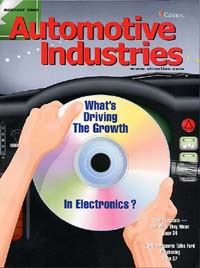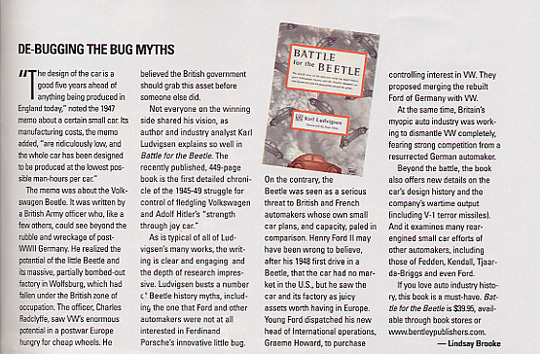|
|
Battle for the Beetle
Price: $64.95
|

Automotive Industries - August 2000
"The design of the car is a good five years ahead of anything being produced in England today," noted the 1947 memo about a certain small car. Its manufacturing costs, the memos added, "are ridiculously low, and the whole car has been designed to be produced at the lowest possible man-hours per car."
The memo was about the Volkswagen Beetle. It was written by a British Army officer who, like a few others, could see beyond the rubble and wreckage of post-WWII Germany. He realized the potential of the little Beetle and is massive, partially bombed-out factory in Wolfsburg, which had fallen under the British zone of occupation. The officer, Charles Radcliff, saw VW's enormous potential in a postwar Europe hungry for cheap wheels. He believed the British government should grab this asset before someone else did.
Not everyone on the winning side shared his vision, as author and industry analyst Karl Ludvigsen explains so well in Battle for the Beetle. The recently published, 449-page book is the first detailed chronicle of fledgling Volkswagen and Adolf Hitler's "strength through joy car."
As is typical of all Ludvigsen's many works, the writing is clear and engaging and the depth of research impressive. Ludvigsen busts a number of Beetle history myths, including the one that Ford and other automakers were not at all interested in Ferdiand Porsche's innovative little bug. On The contrary, the Beetle was seen as a serious threat to British and French automakers whose own small car plans, and capacity, paled in comparison. Henry Ford II may have been wrong to believe after his 1948 first drive in a Beetle, that the car had no market in the U.S., but he saw the car and its factory as juicy assets worth having in Europe. Young Ford dispatched his new head of International operations Graeme Howard, to purchase controlling interest in VW. They proposed merging the rebuilt Ford of Germany with VW.
At the same time, Britain's myopic auto industry was working to dismantle VW completely, fearing strong competition from a resurrected Geramn automaker.
Beyond the battle, the book also offers new details on the car's design history and the company's wartime output (including V-1 terror missiles). And it examines many rear-engineered small car efforts of other automakers, including those of Feddon, Kendal, Tjaar-da-Briggs and even Ford.
If you love auto industry history, this book is a must-have.

Article from and courtesy of Automotive Industries - August 2000
![[B] Bentley Publishers](http://assets1.bentleypublishers.com/images/bentley-logos/bp-banner-234x60-bookblue.jpg)

